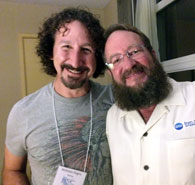BSC: 2014 – Nicholas Dogris and Magnetic Stim
by Siegfried Othmer | December 11th, 2014by Siegfried Othmer, PhD

N icholas Dogris has in a few short years opened up a new technological horizon with what he calls pulsed EMF stimulation, which was developed in collaboration with his electronics engineer partner, Brad Wiitala. What is involved here is simply very low-level magnetic field stimulation within the EEG frequency range and even going beyond it, out to a kiloHertz.
This is powerful stuff, because the neuronal dance can be readily recruited into entrainment even with drive levels as low as one to fifty micro-Tesla, which is orders of magnitude lower than what is being used in rTMS. The power of the technique is not in question. The challenge is to deploy it wisely. In that regard, progress appears to have been made in many directions. In this quest, Nicholas was driven by a very personal cause, namely his own son, who was affected by significant developmental challenges. He had been born prematurely, and was hypoxic upon delivery. It was 2007.
Early in his psychology career, Nicholas was involved in P300 studies, so he was versed in EEG technology. In the late nineties he met Margaret Ayers, and he ended up working as her technician for a couple of years. In the course of that work he accompanied Margaret to a hospital on one occasion, and watched her bring someone out of coma over the course of two hours. His interest in neurofeedback was firmly rooted.
Nicholas migrated to the use of LENS technology because it offered the prospect of working with his less than two-year-old son. That was not thought to be an option at the time for the neurofeedback methods that depended on engagement with the project by the trainee. Nick even contributed some new protocols to the LENS arsenal on the basis of his work with his son. The progress of his son with the LENS became the impetus for the development of his NeuroField system.
I had always thought that the adoption of such low-level magnetic stimulation would be a way to take the abiding mystery out of the LENS—just start with something that we all understand: ordinary magnetic stim. And here Nicholas had done it. But he did not replicate LENS at all, but rather set out in a different direction.
The LENS principle is one of disentrainment, and to all appearances that is not what his son needed. The EEG was bland and lacked variability. Nicholas went in the direction of stimulation by entrainment. He started out differently as well in other respects. Before he introduced magnetic stimulation he was using just voltage transients delivered through an ordinary electrode cap, and that worked rather better than it should. But that just led to yet another mystery to be sorted out. With magnetic stimulation, one’s feet were back on the ground.
After all, there have been precedents for this. Years before there had been a device out of South Korea that induced alpha activity with magnetic stim, but the FDA soon barred it from import. And Chuck Davis has been using magnetic stimulation all along with his pROSHI. And then there are the Shakti coils, etc. These are all the most gentle of methods, and yet they leave no doubt at all that the brain is responsive to such signals.
rTMS was discovered in 1985, the same year that we entered the field of neurofeedback. At every point over this entire period of time, the evidentiary support for neurofeedback has been greater than for rTMS; the theoretical foundation has been sounder; the clinical protocols have been better defined; and the clinical impact of neurofeedback has been vastly larger; and it all comes at vastly lower cost. Now stimulation approaches are available that could be a direct competition to rTMS.
But back to the story. Ever since the early days of episodic DC stimulation, Nicholas has been on his own track in finding effective ways to deploy this new technique. By this time the neurofeedback community had been softened up and chastened by techniques such as LENS that could not be ignored even though they were not understood, and Nicholas found a number of early adopters. It was just the right time.
.jpg)
Photo: (L to R) Nicholas Dogris, Jay Gunkelman





